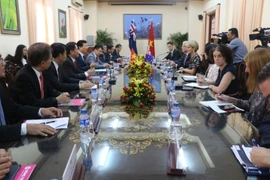Under the CPTPP, Australia will reduce importtax to 5 percent in the first three years after the CPTPP enters into force,and waive itfrom the fourth year.
Truong Van Cam, Vice President and GeneralSecretary of the Vietnam Textile and Apparel Association, said Australia’sapparel imports have grown stably over the past five years, 3-4 percentannually on average. Moreover, apparel retail prices in Australia aremuch higherthe import ones, giving Vietnamese products anadvantage.
However, Australia’s garment imports from Chinahave accounted for more than 60 percent in recent years. Apart from China,India is also working to enter the market.
More than half of participating exhibitors in aninternational exhibition of garment materials held in mid-November in Melbournewere from China and one fourth were from India. In recent years, severalVietnamese enterprises have just joined the event.
According to Cam, Australian businessesoften place small orders at first to explore supply capacity and marketpopularity. If successful, contracts of higher value could be signed at betterprices.
Deputy head of the Ministry of Industry andTrade’s Department of Asia-Africa Markets Nguyen Phuc Nam said Australia is animportant partner of Vietnam in Asia-Pacific. In 2017, Australia importedapparel worth nearly 9.32 billion USD, nearly 173 million USD of which was fromVietnam, roughly 1.9 percent of the total.
Australian companies are focusing more onVietnam due to more competitive workforce costs than China’s.
To access the demanding market, Cam stressed theneed to study demand, improve product design and workers’ skills, and invest inmodern machinery.
Australia has a population of nearly 24 million people with a gross domestic product of nearly 1.39 trillion USD and average incomeper capita of about 50,000 USD each year, said the ministry.-VNA





























